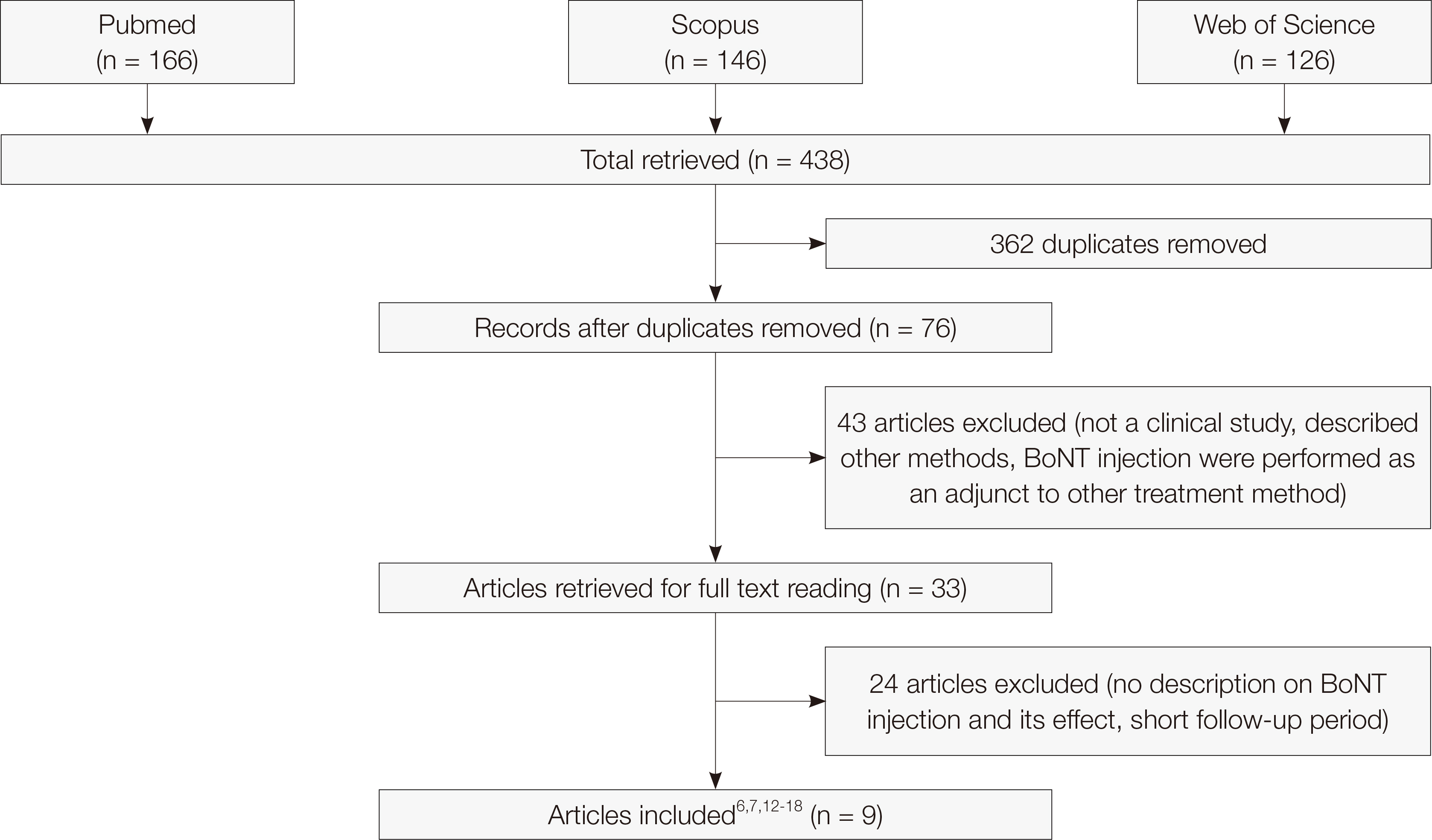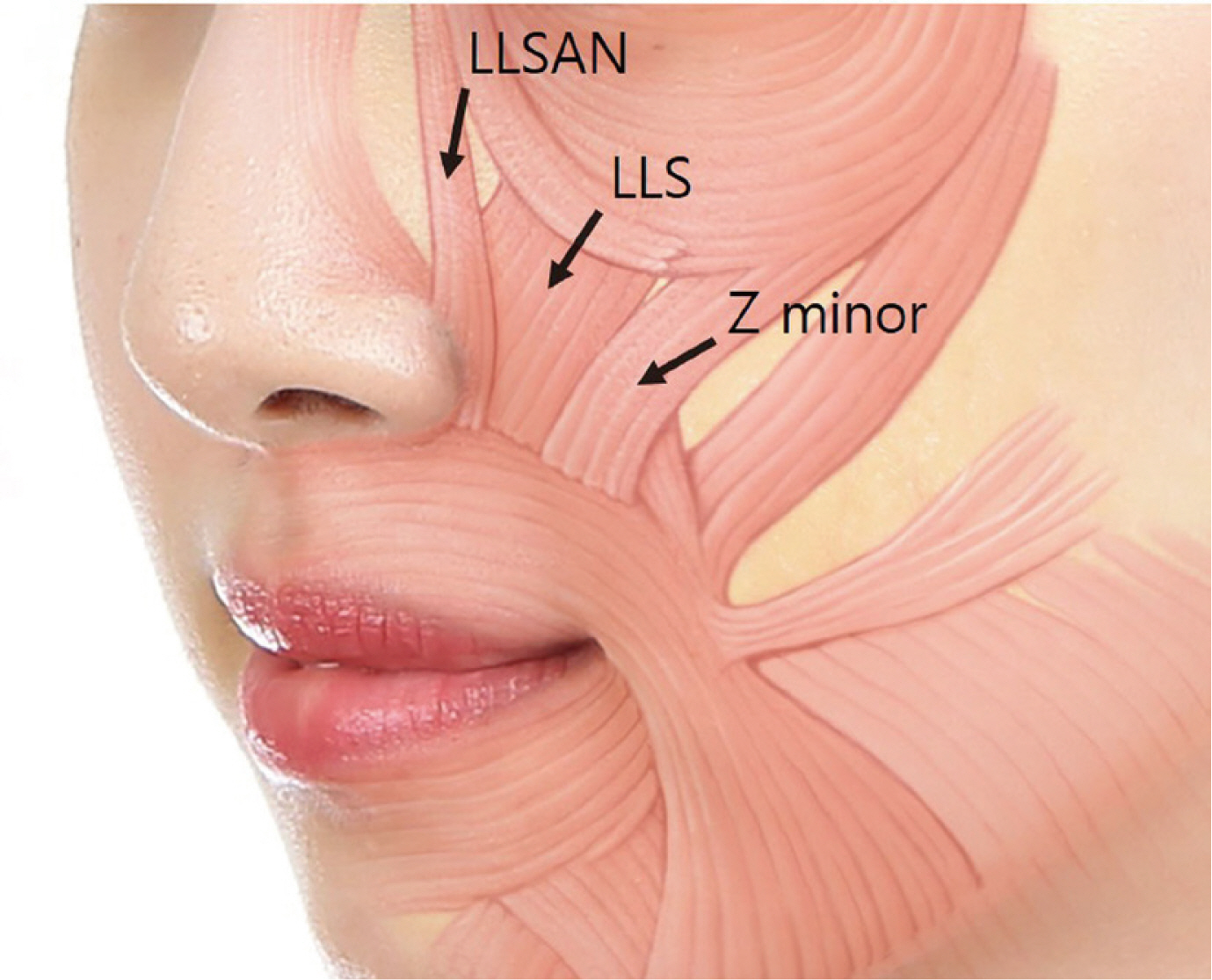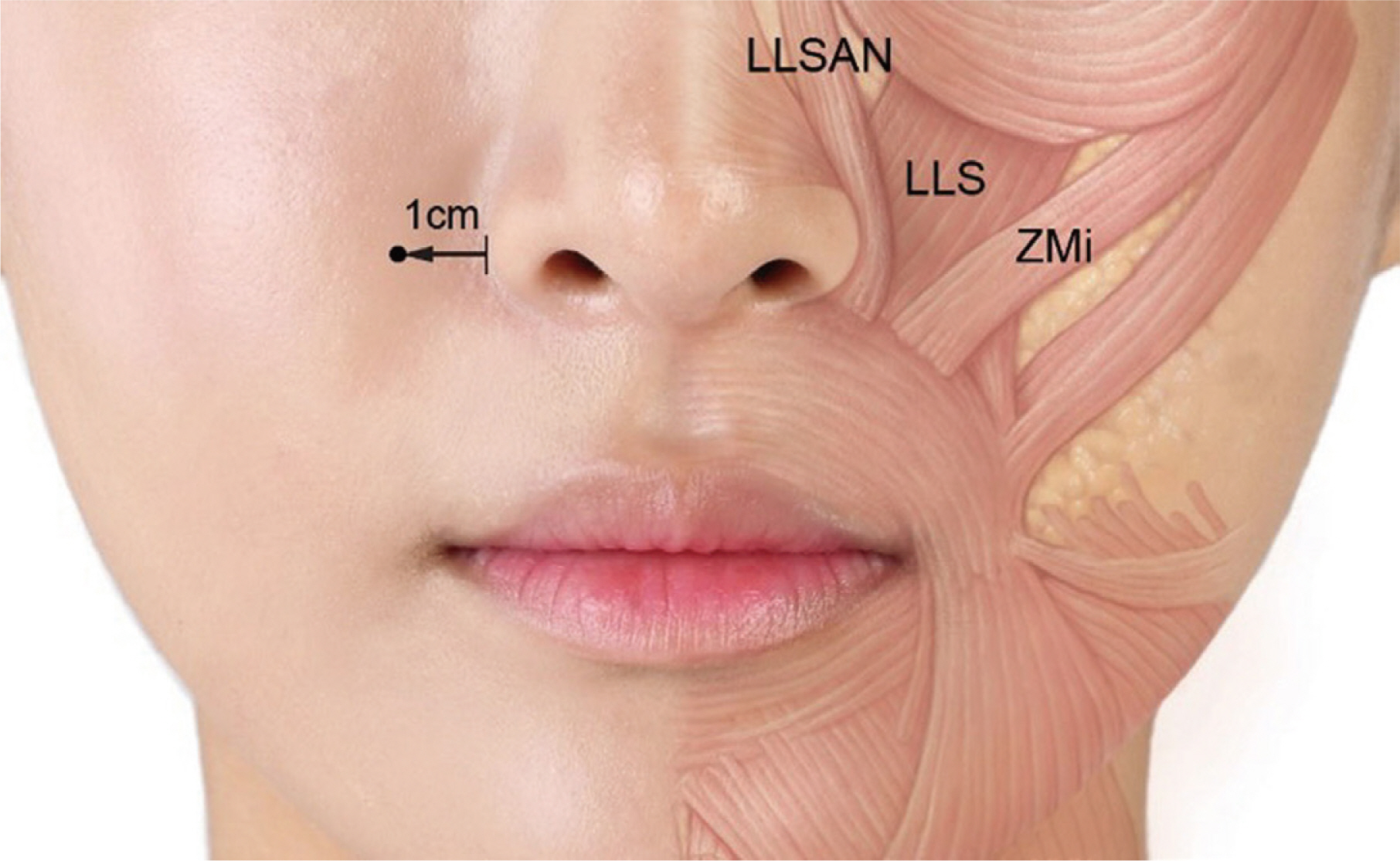J Dent Rehabil Appl Sci.
2021 Jun;37(2):61-72. 10.14368/jdras.2021.37.2.61.
Treatment of gummy smile using botulinum toxin: a review
- Affiliations
-
- 1Department of Orofacial Pain and Oral Medicine, Yonsei University College of Dentistry, Seoul, Republic of Korea
- KMID: 2525979
- DOI: http://doi.org/10.14368/jdras.2021.37.2.61
Abstract
- A beautiful smile is made when it is symmetrical and gums are displayed less than 2 - 3 mm. Excessive gingival display also known as “gummy smile” is often recognized to be unaesthetic. Causes of gummy smile can be caused by delayed eruption, vertical maxillary excess, hypermobile upper lip, or a short upper lip. Meanwhile botulinum toxin which is an exotoxin produced from Clostridium botulinum, works by blocking the release of acetylcholine from the cholinergic nerve end plates leading to inactivity of the muscles.The application site and weakens the muscle tone is drawing attention as a gummy smile treatment caused by hypermobile upper lip. There have been many studies about the method of injecting botulinum toxin into muscles around the lips, but there is still no standardized research method and treatment method, so there is controversy over the therapeutic effect. The aim of this study is to review the previous studies about the predictors of indication and effects of gummy smile treatment using botulinum toxin injection. Especially we tried to propose a protocol for optimal dose and efficient injection point through the anatomical considerations for gummy smile treatment using botulinum toxin.
Keyword
Figure
Reference
-
References
1. Humayun N, Kolhatkar S, Souiyas J, Bhola M. 2010; Mucosal coronally positioned flap for the management of excessive gingival display in the presence of hypermobility of the upper lip and vertical maxillary excess: a case report. J Periodontol. 81:1858–63. DOI: 10.1902/jop.2010.100292. PMID: 20722534.2. Rosenblatt A, Simon Z. 2006; Lip repositioning for reduction of excessive gingival display: a clinical report. Int J Periodontics Restorative Dent. 26:433–7. PMID: 17073353.3. Garber DA, Salama MA. 1996; The aesthetic smile: diagnosis and treatment. Periodontol 2000. 11:18–28. DOI: 10.1111/j.1600-0757.1996.tb00179.x. PMID: 9567953.4. de Souza Pinto EB. 2003; Relationship between tip nasal muscles and the short upper lip. Aesthetic Plast Surg. 27:381–7. DOI: 10.1007/s00266-003-2070-x. PMID: 14612993.5. Grover HS, Gupta A, Luthra S. 2014; Lip repositioning surgery: A pioneering technique for perio-esthetics. Contemp Clin Dent. 5:142–5. DOI: 10.4103/0976-237X.128697. PMID: 24808717. PMCID: PMC4012110.6. Polo M. 2005; Botulinum toxin type A in the treatment of excessive gingival display. Am J Orthod Dentofacial Orthop. 127:214–8. quiz 61DOI: 10.1016/j.ajodo.2004.09.013. PMID: 15750541.7. Mazzuco R, Hexsel D. 2010; Gummy smile and botulinum toxin: a new approach based on the gingival exposure area. J Am Acad Dermatol. 63:1042–51. DOI: 10.1016/j.jaad.2010.02.053. PMID: 21093661.8. Litton C, Fournier P. 1979; Simple surgical correction of the gummy smile. Plast Reconstr Surg. 63:372–3. DOI: 10.1097/00006534-197903000-00014. PMID: 419216.9. Gabrić Pandurić D, Blašković M, Brozović J, Sušić M. 2014; Surgical treatment of excessive gingival display using lip repositioning technique and laser gingivectomy as an alternative to orthognathic surgery. J Oral Maxillofac Surg. 72:404.e1–11. DOI: 10.1016/j.joms.2013.10.016. PMID: 24326017.10. Rao LB, Sangur R, Pradeep S. 2011; Application of Botulinum toxin type A: an arsenal in dentistry. Indian J Dent Res. 22:440–5. DOI: 10.4103/0970-9290.87068. PMID: 22048586.11. Pontes HA, Pontes FS, de Oliveira GF, de Almeida HA, Guimarães DM, Cavallero FC. 2012; Uncommon foreign body reaction caused by botulinum toxin. J Craniofac Surg. 23:e303–5. DOI: 10.1097/SCS.0b013e318252f3e0. PMID: 22801160.12. Polo M. 2008; Botulinum toxin type A (Botox) for the neuromuscular correction of excessive gingival display on smiling (gummy smile). Am J Orthod Dentofacial Orthop. 133:195–203. DOI: 10.1016/j.ajodo.2007.04.033. PMID: 18249285.13. Sucupira E, Abramovitz A. 2012; A simplified method for smile enhancement: botulinum toxin injection for gummy smile. Plast Reconstr Surg. 130:726–8. DOI: 10.1097/PRS.0b013e31825dc32f. PMID: 22929256.14. Singh H, ivastava D Sr, Sharma P, Kapoor P, Roy P. 2014; Redefining treatment of gummy smile with Botox-a report of three cases. Int J Orthod Milwaukee. 25:63–6. PMID: 25745713.15. Suber JS, Dinh TP, Prince MD, Smith PD. 2014; OnabotulinumtoxinA for the treatment of a "gummy smile". Aesthet Surg J. 34:432–7. DOI: 10.1177/1090820X14527603. PMID: 24676413.16. Al Wayli H. 2019; Versatility of botulinum toxin at the Yonsei point for the treatment of gummy smile. Int J Esthet Dent. 14:86–95. PMID: 30714057.17. Cengiz AF, Goymen M, Akcali C. 2020; Efficacy of botulinum toxin for treating a gummy smile. Am J Orthod Dentofacial Orthop. 158:50–8. DOI: 10.1016/j.ajodo.2019.07.014. PMID: 32414547.18. Hexsel D, Dal'Forno T, Camozzato F, Valente I, Soirefmann M, Silva AF, Siega C. 2020; Jul. 28. Effects of different doses of abobotulinumtoxinA for the treatment of anterior gingival smile. Arch Dermatol Res. doi:10.1007/s00403-020-02096-9. DOI: 10.1007/s00403-020-02096-9. PMID: 32725500.19. Fehrenbach MJ, Herring SW. 2002. Illustrated Anatomy of the Head and Neck. 2nd ed. Saunders;Philadelphia:20. Pessa JE. 1992; Improving the acute nasolabial angle and medial nasolabial fold by levator alae muscle resection. Ann Plast Surg. 29:23–30. DOI: 10.1097/00000637-199207000-00006. PMID: 1497293.21. Rubin LR, Mishriki Y, Lee G. 1989; Anatomy of the nasolabial fold: the keystone of the smiling mechanism. Plast Reconstr Surg. 83:1–10. DOI: 10.1097/00006534-198901000-00001. PMID: 2909048.22. Rubinstein A, Kostianovsky A. 1973; Cosmetic surgery for the malformation of the laugh: original technique. Prensa Med Argent. 60:952.23. Ellenbogen R. 1984; Correspondence and brief communications. Plast Reconstr Surg. 73:697–8. DOI: 10.1097/00006534-198404000-00044.24. Niamtu J 3rd. 2008; Botox injections for gummy smiles. Am J Orthod Dentofacial Orthop. 133:782–3. DOI: 10.1016/j.ajodo.2008.04.007. PMID: 18538226.25. Simonetta Moreau M, Cauhepe C, Magues JP, Senard JM. 2003; A double-blind, randomized, comparative study of Dysport® vs. Botox® in primary palmar hyperhidrosis. Br J Dermatol. 149:1041–5. DOI: 10.1111/j.1365-2133.2003.05620.x. PMID: 14632812.26. Kane MA. 2003; The effect of botulinum toxin injections on the nasolabial fold. Plast Reconstr Surg. 112:66S–72S. DOI: 10.1097/01.PRS.0000082195.44980.10. PMID: 14504487.27. Polo M. 2013; A simplified method for smile enhancement: botulinum toxin injection for gummy smile. Plast Reconstr Surg. 131:934e–5e. DOI: 10.1097/PRS.0b013e31828bd8fa. PMID: 23714834.28. Pessa JE, Zadoo VP, Adrian EK Jr, Yuan CH, Aydelotte J, Garza JR. 1998; Variability of the midfacial muscles: analysis of 50 hemifacial cadaver dissections. Plast Reconstr Surg. 102:1888–93. DOI: 10.1097/00006534-199811000-00013. PMID: 9810983.29. Klein AW, Mantell A. 1998; Electromyographic guidance in injecting botulinum toxin. Dermatol Surg. 24:1184–6. DOI: 10.1111/j.1524-4725.1998.tb04096.x. PMID: 9834737.30. Hwang WS, Hur MS, Hu KS, Song WC, Koh KS, Baik HS, Kim ST, Kim HJ, Lee KJ. 2009; Surface anatomy of the lip elevator muscles for the treatment of gummy smile using botulinum toxin. Angle Orthod. 79:70–7. DOI: 10.2319/091407-437.1. PMID: 19123705.31. Carruthers J, Carruthers A. 2004; Botulinum toxin A in the mid and lower face and neck. Dermatol Clin. 22:151–8. DOI: 10.1016/S0733-8635(03)00118-9. PMID: 15222575.32. Chen G, Oranges CM, Giordano S, Huang R, Wang W. 2019; Horizontal animation deformity as unusual complication of neurotoxin modulation of the gummy smile. Dermatol Online J. 25:13030. DOI: 10.5070/D3258045143. PMID: 31553868.33. Ahn BK, Kim YS, Kim HJ, Rho NK, Kim HS. 2013; Consensus Recommendations on the Aesthetic Usage of Botulinum Toxin Type A in A sians. Dermatol Surg. 39:1843–60. DOI: 10.1111/dsu.12317. PMID: 24118218.
- Full Text Links
- Actions
-
Cited
- CITED
-
- Close
- Share
- Similar articles
-
- Clinical Study for Accurate Injection Site of Botulinum Toxin A in the Correction of Gummy Smil
- Treatment of Gingival Smile by Botulinum Toxin A
- Improvements of facial profile and smile aesthetic using temporary anchorage devices and botulinum toxin: a case report
- Urologic Applications of Botulium Toxin
- Application of Botulinum Toxin in Pain Management




